A detailed analysis of the ruling party’s hierarchy by ThePrint reveals it is still dominated by the upper castes and has little room for minority communities.
New Delhi: The Bharatiya Janata Party (BJP) under Narendra Modi and Amit Shah has been working hard to expand its footprint across the country, using social engineering to woo the so-called lower castes and capture voters who traditionally shunned the party.
But when it comes to its own organisational structure, the 38-year-old party continues to remain predominantly upper-caste, with a far less proportion of backward castes and negligible representation of scheduled castes, scheduled tribes and other minority communities.
An in-depth analysis of the caste profile of the BJP’s organisational structure by ThePrint has found that over three-fourths of the party’s office bearers at the national level are upper caste and over 60 per cent of its national executive is drawn from the general category.
General category members also account for 65 per cent of its state unit presidents.
Even in its lower rungs, most leadership roles are with the upper castes — 65 per cent of the BJP’s district presidents across the country are from the general category.
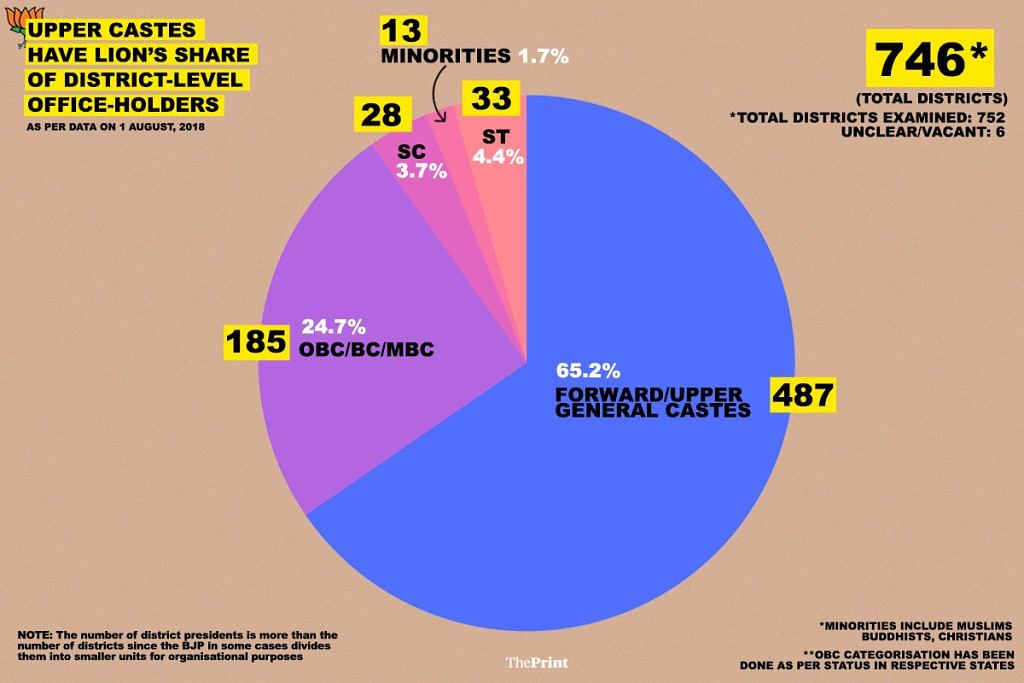
Over the last few years, the BJP’s Dalit outreach has stood out as it tries to shed the perception that it is a Brahmin-Baniya party. That, however, isn’t reflected in the party’s hierarchy either.
Dalits, along with Muslims and tribals, are among the least represented in the party. Only two are national office bearers while none of the state unit presidents is from the community.
The methodology
ThePrint studied the list of the BJP’s 50 national office-bearers, 97 national executive members, 36 presidents of 29 states and seven Union Territories, as well as 752 of the party’s district presidents across 24 states.
The northeastern states, barring Assam and Tripura, are primarily tribal-dominated, and the BJP hierarchy reflects this social composition. Hence, they’ve been left out of this analysis.
Caste categorisation has been done as per the status of a particular caste in that respective state.
Also read: BJP may win more OBC hearts as panel finalises report on refining quotas
Muslims, Buddhists and Christians have been included as minorities.
Sikhs have not been classified as minorities as most of the community’s representatives in the BJP are in its Punjab unit, where they are not a minority. Outside Punjab, there is one Sikh each in the party’s national office-bearers and national executive lists, as well as one each at the district level in Madhya Pradesh and Chhattisgarh.
The lists of national office-bearers and national executive members were obtained from the BJP website.
The national office-bearers include the president, national vice-presidents, national general secretaries, joint general secretaries, national secretaries, national spokespersons and morcha heads. The national executive comprises of BJP leaders from the states.
Those of district presidents were obtained from the party’s state websites wherever available, while some were procured from the respective state units.
The number of district BJP presidents is more than the number of districts in some states as in the case of big districts, the party has appointed more than one head.
Caste determination has been as accurate as possible, but given the complexity of the exercise of caste identification, there could be room for some minor corrections.
The Big Picture: BJP remains an upper caste party
Of the BJP’s 50 national office-bearers, 17 are Brahmins, 21 are from other forward castes, four are OBCs, three belong to the scheduled castes, two are scheduled tribes, two are from the Muslim community, and one is Sikh.
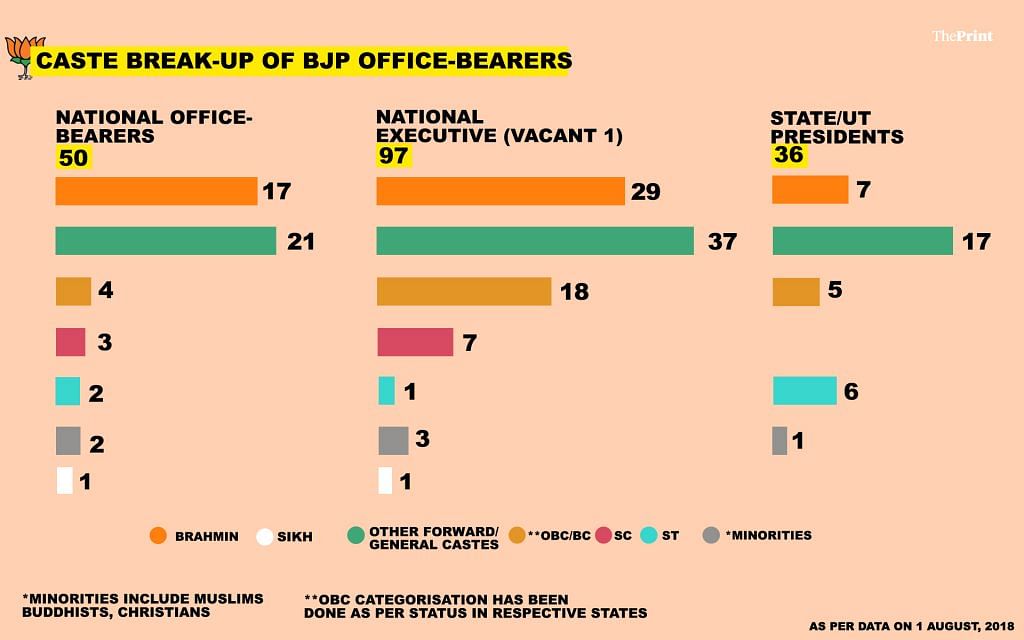
Such is the poor representation of minorities in the BJP’s highest decision-making body, that of the three Dalits, one is the head of the party’s SC morcha, while of the two Muslims, one is the chief of the minority morcha.
It is even worse in the case of tribal representatives, as one is the head of the party’s ST morcha, while the other, Jyoti Dhruve from Madhya Pradesh, is embroiled in a controversy over her status. The state government has scrapped her ST certificate and the matter is in court.
In effect, 76 per cent of the party’s national office-bearers are upper castes, while only 8 per cent are OBCs and 6 per cent are SC.
It is equally lopsided in the party’s national executive. Of the 97 members here, 29 are Brahmins, 37 are from other upper castes, 18 are either OBCs or BCs, seven belong to the Scheduled Castes, three are from minority communities, one is a Sikh and one is an ST.
One seat is vacant after Chandan Mitra quit the party last month.
Effectively, 69 per cent are from forward castes and only around 27 per cent are from the other communities.
Among BJP presidents, of the 36 state units and those of the union territories, none is Dalit. Seven are Brahmins, 17 belong to other forward castes, six are STs, five are OBCs and one is Muslim. Over 66 per cent are, thus, from the upper castes.
Even at the district level, 65 per cent of the party’s presidents are upper castes, with more than a fourth of them being Brahmin. While the BJP is supposed to have 752 district presidents, data is available for 746 as three positions are vacant, and the castes of three district presidents remain unclear.
Of these, 487 are upper castes, 25 per cent belong to the OBC, BC, MBC categories, while less than 4 per cent are SCs. Not even 2 per cent are from the minority communities.
None of this is commensurate with each community’s share in the population. As per the 2011 census, Dalits comprise 16.6 per cent of the country’s population while scheduled tribes are 8.6 per cent of the population. Muslims constitute around 14 per cent of the population.
While there are no exact figures for other castes, with data for the caste census yet to be released, a survey by the National Sample Survey Organisation (NSSO) in 2007 pegged the OBC population at around 41 per cent.
In states, the same story in UP and Bihar
In Uttar Pradesh, where the BJP came to power with a thumping majority in 2017 by building a rainbow caste coalition, the party structure is overwhelmingly upper caste with around 72 per cent of the district presidents belonging to the general category. Of these, around 30 per cent are Brahmins, 15 per cent are Baniyas and 26 per cent are other forward castes.
Dalits are 21 per cent of the population but have only two district presidents. OBCs comprise 26 per cent of the district presidents.
While UP has 71 districts, the party has split some of them for administrative reasons and thus, it has 92 district presidents in the state.
The other state where the BJP hopes to make gains in 2019 is Bihar, where victory in the 2015 assembly elections eluded it. Of the total 40 district presidents, six are Brahmins, 16 belong to other upper castes, 11 are OBCs, 6 are EBCs and one is SC. There are no Dalit presidents.
In effect, 55 per cent are upper castes, while 11 per cent are from the OBC/EBC categories.
Poll-bound states
Ahead of the Lok Sabha polls next year, the BJP has to first contend with semi-finals in three key states: Rajasthan, Madhya Pradesh and Chhattisgarh. It is in power in all of them.
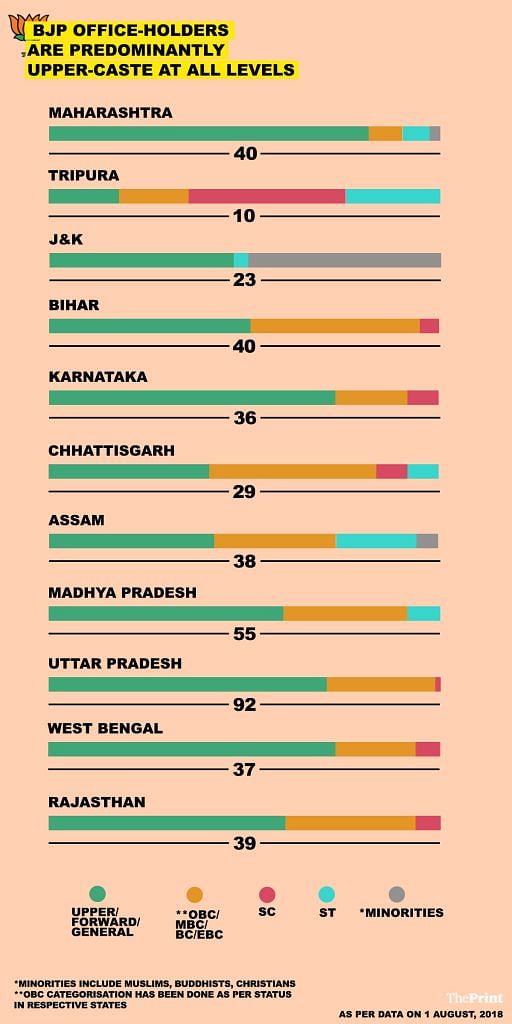
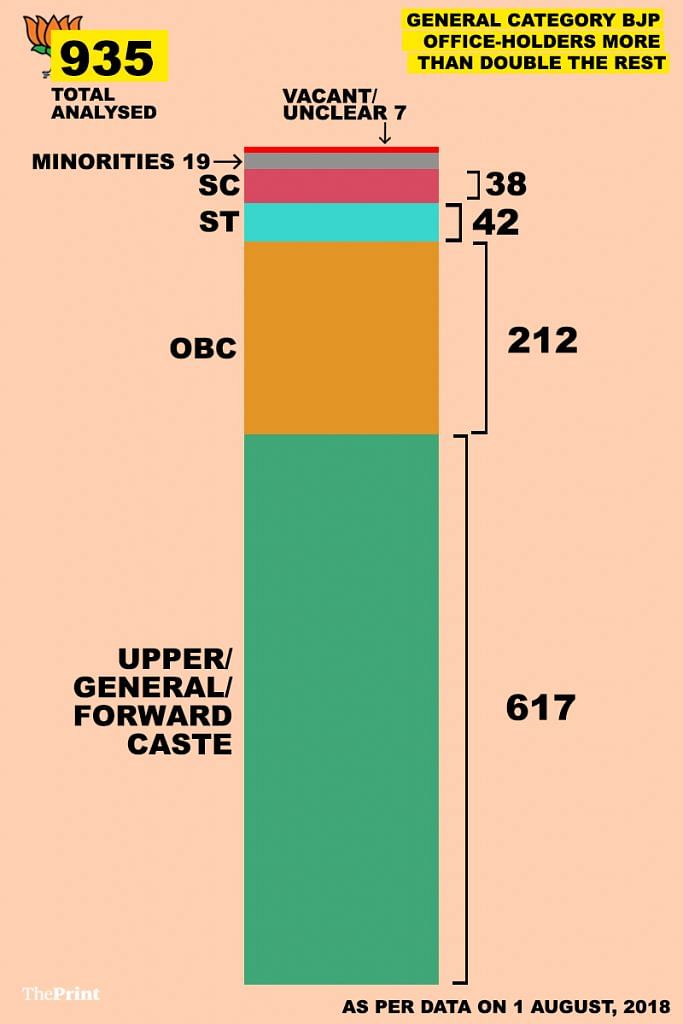
In Madhya Pradesh, Brahmins, Baniyas and other upper castes head 70 per cent of the districts, while OBCs are in 25 per cent of the posts and STs in 4 per cent. Of the total 55 district presidents, 13 are Baniyas and 6 are Brahmins. There is one Sikh.
In Rajasthan, where the party suffered embarrassing defeats in two Lok Sabha bypolls earlier this year, 71 per cent of the district presidents are upper castes (including Brahmins, Baniyas, Jains, Rajputs, Kayasthas), 23 per cent are OBCs and two are from the scheduled castes.
In the third poll-bound state of Chhattisgarh, the party has a significant percentage of OBCs as district presidents — around 45 per cent; 41 per cent are upper castes (which includes 3 per cent Brahmins, 17 per cent Baniyas and 21 per cent of other upper castes) and around 7 per cent each are SC and ST.
Western states
In Prime Minister Narendra Modi’s home state of Gujarat, there are three Brahmins and 21 from other upper castes among the 41 district presidents. Six are tribals, eight are OBCs and three are SCs.
The powerful Patels, who are now campaigning for reservation, make up 31 per cent of the district presidents.
In neighbouring Maharashtra, of the 40 district presidents, the influential Maratha community (15), which is demanding reservations, has the maximum representation. Of the rest, 11 are Brahmins, six are from other forward castes, four are OBCs, three STs, one Muslim and none from the scheduled castes.
The east
In the east, of the 37 district presidents in West Bengal, only two are SCs, and five OBCs. The rest belong to the general category. In Assam, which has a BJP government, around 45 per cent of its district presidents are either Brahmins or belong to other forward castes. Around 32 per cent are OBCs or MBCs, 21 per cent are STs, and one Muslim.
The south and north
Among the southern states, of the 36 district presidents in Karnataka, 28 belong to the general category. Of the 36, 19 are Lingayats, seven Vokkaligas, two others (general), five OBCs and three SCs.
In Tamil Nadu, where the BJP is looking to forge an alliance with the AIADMK, an overwhelming majority — 71 per cent — belong to backward castes, while 26 per cent are forward castes. There are no SCs.
In the northernmost state of Jammu and Kashmir, of the 23 district presidents, 43 per cent, primarily in Jammu, are from the upper castes and 48 per cent, all in the Valley, are Muslim.
‘The PM is an OBC’
When ThePrint reached BJP leaders for comment, they refused to speak on record over the issue. Sources, however, said the party tries to take into account local caste dynamics while appointing district presidents.
“The balancing act is often done to get in representations from the different dominant caste groups while forming district units in terms of all the members picked (besides the president), as also while selecting city and village unit heads,” said the source.
“The PM is an OBC. This shows we are a party of and for the backward castes. Change will happen only gradually and will reflect in the party hierarchy accordingly. It cannot happen overnight,” said another senior leader who also spoke on condition of anonymity.
Also read: Four years of Narendra Modi have not just failed India’s middle class but also the RSS
Special contributors: Ratnadeep Choudhary and Rupanwita Bhattacharjee
With inputs from Manasi Phadke, Chitleen Sethi, Rohini Swamy, Gaurav Kumar and Sakshi Arora
Editor’s Note: ThePrint has attempted to be as accurate with castes as possible but it welcomes corrections, if any, from readers.


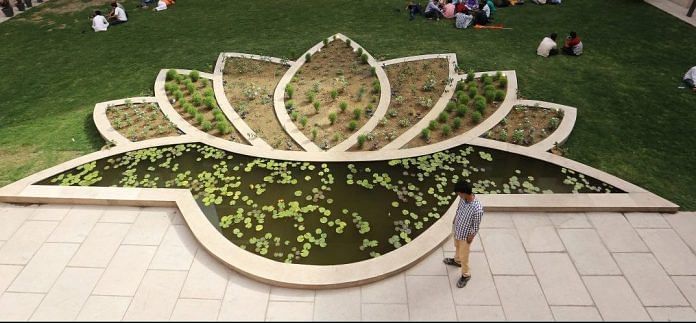

OBC se dar lagna swabhavik hai BJP and Congress ko .
Aur BAMCEF ki raftar to ab bahut tej hai .
This article is completely bogus! Even the study has been designed in a way to spice up things and reflect what the author wants to show. For your kind information, Jains are not upper caste Hindus but a minority religion. It proves that either the writer of this article is not educated enough to know that or he wants to misrepresent facts.
இதில் ஆச்சரியப்பட என்ன இருக்கிறது…!!!
பி.ஜே.பி என்பதே பிராமின்ஸ் ஜனதா பார்ட்டி தானே…
உயா்சாதிக்கான கட்சி என்பதில் யாருக்கும் எந்த மாற்று கருத்தும் இருக்காது…
ஏன் என்றால் பிஜேபியை இயக்குவது ஆர்.எஸ்.எஸ் அதன் தலைவராக வேறு யாரும் வர முடியுமா?
சித்பவன் பார்ப்பனர் தவிர வேறு யாரும் ஆர்.எஸ்.எஸ் தலைவராக வர முடியாது…
இது தான் உண்மை…
பி.ஜே.பியின் தலைமையிடம் ஆர்.எஸ்.எஸ்…
ஆர்.எஸ்.எஸ் என்பது
ஒடுக்கப்பட்ட, தாழ்த்தப்பட்ட, சிறுபாண்மை முஸ்ஸிம், கிறிஸ்தவா்கள், பழங்குடியினா் இவா்களுக்கு எதிரான ஓர் அமைப்பு…
ஆர்.எஸ்.எஸ் ஓர் ஆபத்தான இயக்கம்
தற்போது தமிழ்நாட்டில் பள்ளர்களை குறி வைத்துள்ளனா்…
அவர்கள் அறியாமையில் இருப்பதால் அவா்களுடைய ஓட்டை பெறுவதற்காக உசந்த சாதி எண்ணத்தை மனதில் விதைத்து இடஒதுக்கீட்டை காலி பண்ண துடிக்கின்றனர்…
அவா்களோட தலைமைகளின் சுயநலத்திற்காக பள்ளர்களை பலியாடுகளாக மாற்ற துடிக்கின்றனா்…
இது ஆபத்தான போக்கு…
அப்பாவி பள்ளர் இனத்தை மதவெறி கும்பலுடன் இனைத்து பள்ளர்களை இரண்டு குழுவாக பிரித்து ஆள திட்டமிட்டுள்ளனர்…
ஆர்.எஸ்.எஸ்ற்கு அடியாளாக மாற்ற திட்டமிட்டுள்ளனா்…
பெரும்பாலும் அந்த கட்சியில் சேர்ந்த பள்ளர்களுக்கு எஸ்.சி அணியில் தான் பொறுப்புகள் கொடுத்துள்ளனா்…
மாநில அந்தஸ்து அல்லது தேசிய அந்தஸ்து பதவியை அவா்களுக்கு வழங்கவில்லை…
3% உள்ள பார்ப்பனர்களான எச்.ராஜா, சுப்பிரமணியசாமி, இல.கணேசன், கே.டி. ராகவன், பலவேசம் சுப்பிரமணியன், ஆடிட்டர் குருமூர்த்தி, பாஜக ஆதரவு பத்திரிக்கையாளர்களான பத்ரி ஷேஸசாத்திரி, கோலகால ஶ்ரீனிவாசம் போன்றவா்களே முன்னிலையில் உள்ளனா்…
தேவேந்திர குல வேளாளர்கள் இவர்களிடம் விலகி இருப்பதே நல்லது…
இவர்களால் நன்மை உண்டாவதை விட தீமை தான் வந்து சேரும் என்பதை அறியாமையில் இருக்கின்றனர்…
எப்போது இவர்களோட சுயரூபத்தை உணர்ந்து விலகி நிற்க போகிறாா்களா?
இல்லை
பள்ளர்கள் படுகுழியில் விழப்போகிறாா்களா என்பதை பொருத்து இருந்து பார்ப்போம்…
காலம் பதில் சொல்லும்.
BJP- BRAHMINS JANATHA PARTY
It seems that the writers, Ruhi Tewari & Pragya Kaushik are trying only to in headlines. That’s why they have chosen such nasty topic of caste propaganda of creating rifts in society. It seems they are paid by intolerance gang. The intention of the writer is to establish themselves as pseudo-intellecual, which is highly condemnable.
It is unfortunate to say that the author is having caste based eye glass. He should know that RSS is collection of educated people. In ancient time mostly Brahmin were educated, later Kayastha became pioneer in education and now a days all caste are equally educated. Baniyas are also educated and progressive too.
Any progressive society will emerge out automatically. Such caste based article should be boycotted.
It’s shit in a simple word, one side u sheudo seculars wants country should be impartial and free of cast of religion and write so long articles on cast. Only BJP party has PM from OBC & made president from Muslim and president from Maha dalit in your words. Let u survey on your Master party i.e. congress about thier party president, pm and CM till now since independence. You wire, carvan, tehalka etc are just mouthpiece of Congress and left parties
It is well known to all that our Bharat Varsh has lost the prestige, educational identity, religious identity, cultural identity etc only due to castism. Then why the writer is renewing such rubbish cast based article, one should avoid to renew such rubbish cast based articles especially when the society is forgetting these.
Society has but politicians haven’t
The most stupid survey ! I dont have to do any survey of your reporters and editors for one line is enough, they are all barbadiwalas and you do this paid journalism ! Can you do this for left ? Congress and Muslims ? Stop spitting venom ! Elections have proved that present generation moved away from caste but you keep harping it ? How many Dalits you have in your team ? How many tribals ?
What about the DMK? What is the representation in the DMK of the non–reserved class Hindus?
When Congress started and ruled for 50+ years what is he staistics of Dalit minorities and lower caste can you analyse.
Who said there is any difference between Congress and BJP.. The caste composition is almost same in both parties.. They just involve in friendly match, while alternating power between them.
Yes
The Father of India: A BANIYA (or as they call them in the region a Vanya)
The Father of Pakistan: technically a BANIYA (or as they call them – Lohana)
So lets strip Gandhi of the Title and give it to Rahul Gandhi: that way we will have a hybrid of 50% Italian and 25% Kashmiri and 25% Persian Parsi
Prof PK Sharma, Freelance Journalist,Barnala(Punjab)
An informative and eye-opening piece indeed !
It should not be read in between the lines with a narrow-minded bent of mind !
It also paints a beautiful picture of India’s diversity in its true colours !
Those friends who wish to escape truth must bear in mind for how long can
we run away from truth ?
We must learn the art of facing truth irrespective of either political or electoral
gains !
The Print will do a great favour to the nation by analysing caste picture division
in other political parties too!
Prof PK Sharma, Freelance Journalist
Pom Anm Nest, Barnala(Punjab)
It was a frivolous exercise.What if the whole party hierarchy non Brahmin – Baniya,. Is Modi is a backward cast? What benefit it brings to the backwards.The moment the Brahminical lobby feels he is turning against them he will be out.Who ever lower cast is in the BJP is simply a tool of the upper cast.Like Modi.A convenient’ pliant tolo. Modi is kept in power to do the bidding for the lobby
Wonderful job.
Well done.
You have exposed them
ThePrint- bunch of crooks…aur Kya expect Kar sakte ho inse..
Hahahahaha
Do you call this as journalism? I actually came on this site to read a different article which was a sensible one n I thought this could b a good site but then I read the headline of this one which made me to just write my comment without reading the article. My comment is “hahahahaha ?” which sums up everything. One question- do you really pay for things like this? I won’t b coming again which is for sure now
On top of everything very recently in March, 2017 when BJP won a landslide victory in Uttar Pradesh under the leadership of the then State BJP president Mr. Keshav Prasad Maurya (OBC leader and MBC in Uttar Pradesh) where he campaigned aggressively to bring in OBC and MBC community in UP to vote for BJP breaking the barrier of only the Brahmin and Bhaniya voters who traditionally vote for BJP was deliberately sidelined by RSS, Narendra Modi and Amit Shah like lynch sucking the blood and made Yogi adithyanath (a Rajput) the CM of Uttar Pradesh.
To substantiate this let me point out the Ministerial representation given by RSS and Narendra Modi led BJP Union government from Tamil Nadu. Mr. Pon. Radhakrishnan who has been the lone face of BJP right from its political birth in Tamil Nadu who won 1998, 1999 and 2014 lok sabha election from Kanyakumari also belonging to a prominent caste called Nadars (OBC) was made Minister of State for various portfolios in 1998 and 1999 Vajpayee governments is still remains a Minister of State in 2014 Modi Government without even an elevating him as MoS (Independent Charge) given his seniority and wide experience. But whereas a navie like Mrs. Nirmala Sitaraman a Tamil brahmin (who constiute 1 % of entire Tamil Nadu population and 2 % of entire South Indian population) who has never ever contested an Municipal ward or panchayat election in her life time became a Member of the BJP only in 2008 is made MoS (Independent Charge) of the heavy weight portfolio of Commerce and Industry in 2014 government when she was not even an Rajya Sabha MP. (later elected to the Rajya Sabha from Andhra Pradesh and Karnataka) The RSS, BJP, Narendra Modi and Amit Shah went on to elevate her to the powerful position as Defence Minister itself is self explanatory to the world on the dominant Brahmin, Bhaniya and elite class mentality of RSS and BJP.
Shitty print media… Why are you dividing our country on the basis of caste… Why such kind of caste based analysis???? Due to cheap media like you …. you are dividing our country on the basis of caste , Colour and religion… you fuckin asshole… Stop doing that….
Dividing country on cast basis? Who did it?This division was there for millennia.You or me can’t run away from that fact.You want to use or aply them conveniently to benefit you.That is all.The expletives betray your intentions and mentality.
right
Would be interested to read a similar report on INC, more interesting would be to see, which Caste they cast the Gandhi’s, Bhramin(Nehru lineage), Baniya(Ghandhi lineage), Muslim/Parsi(Gandhy lineage), Christian( SoniaG lineage). Also let’s talk about CPIM …my estimates are they are 90% Bhramins …rest of the parties have majority of representation from which Thier family party presidents are…like SP and RJD would have a minority of Yadav’s…AIMIM would have majority of Muslims…etc…
This is a prejudiced article. Have they done a similar survey of other parties. If Muslims don’t join the BJP, how can the leaders come in party. Inspite of such situation, a large number of Muslim leaders have come in BJP as BJP wants to be inclusive without appeasement. Article aims to tell the minorities that they don’t have a place in BJP. Bias is naked in article
I analyze your background. Both are not virgin anymore. Both are paid slut.
Thanks for the beautiful article. would suggest you to publish in EPW.
Daft morons…its not caste but India first. U caste aspersions on Dr Kalam and current president & vice president. To all reading this post you want India to progress or Regress?
At least they don’t have an Italian as the one points decision maker of the party
Excellent report Sir/Madam. Very exhaustive and useful. Please do the same for Congress and other parties.
Most of the RSS leaders came from the science stream in education. Starting from the founding sarsanghchalak Dr. K. B. Hegdewar (LSMF, Medical degree) to Guru M.S. Golwalkar, the successor of Hegdewar as sarsanghchalak (M.Sc Bio) to Ashok Singhal (B. Tech), Indresh (B. Tech), Krishan Gopal (Sharma) (M.Sc. Bio-technology), Sanjay Joshi (B. Tech), Dr. Murli Manohar Joshi (M.Sc. Physics), another sarsanghchalak, Prof. Rajinder Singh alias Rajju Bhaiya (M.Sc. Physics), another sarsanghchalak, K.S. Sudarshan , ( B. Tech.) and the current sarsanghchalak Mohan Bhagwat (Veterinary Science & Animal Husbandry). M.D. Deoras (LL.B.), another sarsanghchalak was an exception. There are mixed breed guys also such as Ratan Sharda – MA in Economics & Diploma in Textile Chemistry; Ram Madhav, Diploma in Electrical Engineering and MA in Political Science. That is why their approach towards the human values, polity and social structure etc. remain inflexible. Deen Dayal Upadhay, Sangh’s foremost thinker, too studied science up to intermediate class level but was a postgraduate in English literature and that too with colours. Balraj Madhok (who later had to quit the party), Nanaji Deshmukh, L..K. Advani, Atal Behari Vajpeyi and Narendra Modi, earned their post-graduation degrees in subjects of humanities. The last two became the Prime Ministers of India.
35% Non upper castes is not a bad figure. I think it might be the best figure in Indian political setup.
Nice work, but can we get details about other parties in comparison?
The print itself biased
Eye opener for those, who blindly believing this mandali of Jumlebaj. They are dangerous, just because of such groups country suffered thousands of years. Earlier the best. At any cost country should get rid of this mandali of Jumlebaj in 2019.
Sarkari Muslims one can understand, but it seems that even the Dalits and the Adivasis are largely an ornamental presence. Often in life, stereotypes show us the true picture.
Methodology: 1) The northeastern states, barring Assam and Tripura, are primarily tribal-dominated, and the BJP hierarchy reflects this social composition. Hence, they’ve been left out of this analysis.
2) The northeastern states, barring Assam and Tripura, are primarily tribal-dominated, and the BJP hierarchy reflects this social composition. Hence, they’ve been left out of this analysis.
3) Caste categorisation has been done as per the status of a particular caste in that respective state.
4) Muslims, Buddhists and Christians have been included as minorities.
5) Sikhs have not been classified as minorities as most of the community’s representatives in the BJP are in its Punjab unit, where they are not a minority. Outside Punjab, there is one Sikh each in the party’s national office-bearers and national executive lists, as well as one each at the district level in Madhya Pradesh and Chhattisgarh.
Well, you must be using “Indian statistics” to use such methods, maybe “Secular Statistics”, “Progressive Statistics” or in short Entitlement Statistics,
Well, a just plain science of Statistics does not allow for such a methodology.
Waiting for the analysis of INDIAN NATIONAL CONGRESS. Do you hav the guts to do that??????????
Why congress
Survey all sikular parties
Trinamul
Dmk.admk bjd
No guts to do so
Congress is a Ghandi Family party that will not spell the name correctly or the people will figure that the family is not Indian but Parsi in origin.